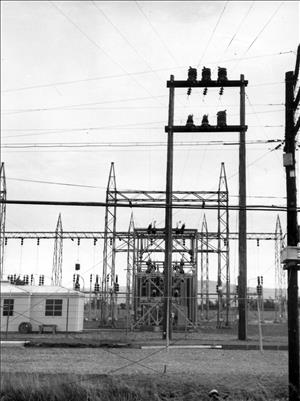On March 31, 1941, construction of the Bonneville Power Administration (BPA) substation in Ellensburg is completed, setting the stage for the arrival of low-cost electricity in Central Washington. The substation is part of the transmission-distribution system being developed by BPA, the federal agency created to distribute electricity from hydropower dams built on the Columbia River. It will provide electricity to the City of Ellensburg's municipal light department, formed 50 years earlier as one of the first public utilities in Washington, and to the recently created Kitsap County Public Utility District, which will bring electric power to rural communities across the county.
Lighting It Up
Long before the BPA substation came on line, Ellensburg already had a history as an early adopter of electric-utility systems. Within a few years after it incorporated (in November 1883), it was one of just three towns in Washington Territory to have a direct-current Edison electric-light and power-station system. The coal-powered steam plant at 4th Avenue and Kittitas Street began operating in 1885 or 1886. It delivered power at 110 volts to a maximum distance of one half mile. The City of Ellensburg bought that plant and its distribution system from John Shoudy in 1891, becoming one of the earliest Washington cities to have a municipal light department. In 1905, the city switched to a new hydroelectric plant on the Yakima River. That plant provided Ellensburg's electricity until 1926, when the city utility became a customer of Puget Sound Power and Light Company.
While Ellensburg had electricity, much of surrounding Kittitas County did not. But power increasingly reached farms and rural communities because of a combination of developments. First, in 1930, came a statewide public power law that authorized a county's voters to approve a public utility district (PUD) to distribute electricity county-wide. A PUD could levy taxes and buy, lease, or condemn property belonging to private power companies within the district. Kittitas County was among those forming a PUD. Next, in 1936, Congress passed the Rural Electrification Act, creating a federal agency to loan PUDs money to build electrical systems. Finally, in 1937, came the Bonneville Project Act. It created a federal agency to market and transmit power from dams on the Columbia River throughout the Pacific Northwest, giving preference and relatively low rates to public systems such as PUDs and electric cooperatives.
The agency, which adopted the name Bonneville Power Administration in 1940, set as the cost of its power a so-called "postage-stamp rate" -- one that was the same for all customers regardless of how far the electricity had to travel to reach them. It also developed a master grid for its original transmission-distribution system. Ellensburg was the site for one of 55 substations on that grid. The substations would have transformers to reduce the electricity from high-powered lines to useable levels and direct it to retail customers and/or other substations.
In August 1940, Ellensburg's city light department signed a five-year contract to get its power from BPA, thus becoming one of the agency's first two municipal customers in Washington. (Centralia was the other one. There were five more in Oregon.)
Building the Substation
The Ellensburg Substation site was a 1.5 acre plot on West Dolarway Road. Construction began in January 1941. Designed and built by BPA, the substation consisted of a fenced switchyard with transformers and other equipment and a single-story 12-by-12-foot control house with wood walls and a metal roof. Shortly after construction was completed, BPA's 115,000 volt line into Ellensburg was energized.
Ellensburg still generated some power from its own hydroelectric plant, but in May 1941, with the substation fully operational, the city stopped buying electricity from Puget Sound Power and relied exclusively on BPA for purchased power. As a result, the city utility reported a 25 percent decrease in its commercial and residential rates, making them the lowest in the state. In 1951, one of the turbines at the city's hydroelectric plant failed, and from then on the city bought all its power from BPA.
Kittitas County PUD, which leased a small portion of the switchyard, also benefitted from BPA's presence. Completion of the high-powered line into Ellensburg allowed for connections into other parts of the county. As a result, rural communities gained electric lights and power to run appliances and small motors. The quality of life on farms was greatly improved.
Spreading the Power
Over the succeeding decades, the Ellensburg Substation underwent numerous but relatively small changes, including construction of a 10-by-12-foot addition to the control house in 1954, erection of some outbuildings, and periodic upgrades of electrical equipment. In 2015, BPA proposed replacing the original control house, which was prone to flooding, with a prefabricated 28-by-35-foot power control assembly. The old control house was scheduled for demolition in the summer of 2018.
From the time of its creation as part of the original master grid, the original Ellensburg Substation has been owned and operated by BPA. By 2012 the Kittitas County PUD was providing power to rural areas of the county from Vantage to Cle Elum, serving about 4,800 customers. In continuous operation since 1891, the City of Ellensburg Light Department is believed to be the state's oldest municipal electric utility.

